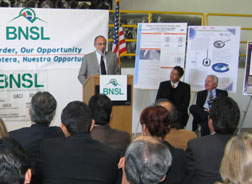NEWS RELEASES
FOR IMMEDIATE RELEASE
December 12, 2005
BiNational Sustainability Laboratory opens shop, hopes to create ‘necklace of labs’ along Mexican border
Dream of Sandia’s Advanced Concept Group for better border security takes on flesh, though somewhat altered
 GERRY YONAS addresses session announcing the opening
of the Bi-National Sustainability Laboratory at Santa Teresa,
N.M.
GERRY YONAS addresses session announcing the opening
of the Bi-National Sustainability Laboratory at Santa Teresa,
N.M.Download 300dpi JPEG image, “binational-yonas.jpg,” 676K (Media are welcome to download/publish this image with related news stories.)
ALBUQUERQUE, N.M. — After four years of preparation, the BiNational Sustainability Laboratory announced itself ready for business in a 4,000-square-foot facility in Santa Teresa, N.M., a short ride east from El Paso and a few miles from the Mexican border.
The two-hour opening ceremony on Nov. 18 was attended by approximately 125 dignitaries, entrepreneurs, and researchers.
“This will be a wonderful opportunity for collaborative technical efforts to enhance border security,” said Sandia National Laboratories vice president Gerry Yonas, who was the first to envision a border laboratory and who led the fight for its existence. “This is a perfect opportunity to follow up on work with Canada and Mexico to foster a continental approach in dealing with terrorism.”
The BNSL — a collaboration initiated and championed by Sandia’s Advanced Concept Group — is financially supported by the United States, Mexico, and the State of New Mexico. Sandia is a National Nuclear Security Administration laboratory.
The general purpose of the fledgling enterprise is to change the U.S.-Mexican border from a political trouble spot to a necklace of research centers stretching from the Gulf Coast to the Pacific. Success would be defined by the number of research ideas its personnel could morph into functioning, profit-making companies, with better paying jobs on both sides of the border the hoped-for result.
Border security is an obvious possible project. Other projects of current interest include environmental and water technologies, advanced materials for petroleum processing, and microelectromechanical systems (MEMS).
The U.S. Economic Development Administration of the Dept. of Commerce and Mexico’s CONACyT [Mexican National Council of Science and Technology, a cabinet-level group that reports directly to President Vicente Fox] contributed initial funding of $400,000 each, and the State of New Mexico’s Economic Development Department, $100,000. Ten states on both sides of the border have expressed interest in taking part in the project, as have U.S. and Mexican national laboratories, research universities and centers, and businesses.
Secretary of New Mexico’s Economic Development Dept. Rick Homans said, “Today takes us from a concept on paper to a project housed in a building — a huge step forward.”
A spokesperson for the Mexican National Council of Science and Technology (CONACyT) said in Spanish that “people around the world are interested in copying this model; even though we have only just started, it is a dream shared. It’s like we are on the field in a stadium and they are looking at us from many parts of the stadium, from many parts of the world. We hope this will change the way borders are looked at.”
The BNSL was envisioned initially as occupying a large building — “a shining laboratory on a hill,” or at least, on the border — in which Mexican and U.S. researchers would work on the knotty problems that might one day cause enmity between neighbors. Solutions would include better border crossing sensors and arrangements, more efficient use of water, research into areas of joint interest like crop development in arid regions, and a central location where Mexican and U.S. researchers could share cultures.
This has evolved into a vision of a main lab in Santa Teresa, says Yonas, and a subsidiary string of small research centers that the BNSL would help fund. These would provide training and cross-border legal and patent expertise, as well as some laboratory space, and bring together researchers in government, universities, and private industry to create marketable goods that will bring to life and make more secure the somewhat desolate border region.
In both versions, the BNSL is expected to provide business planning, mentoring, incubation, marketing techniques, and aid in morphing technological ideas into developed products
“We envision ourselves as an engine of research excellence for sustained economic development [east and west along] the US-Mexico border,” said BNSL president Paul Maxwell.
Yonas, who spoke briefly, described himself as “a card-carrying physicist and dreamer” and compared the BNSL’s task to that of sherpas who accompany tourist mountain climbers to the top of Mt. Everest over and over without recognition.
“The BNSL’s activities will require steady, careful, sherpa mountain climbing,” he said.
Sandia is a multiprogram laboratory operated by Sandia Corporation, a Lockheed Martin company, for the U.S. Department of Energy’s National Nuclear Security Administration. Sandia has major R&D responsibilities in national security, energy and environmental technologies, and economic competitiveness.
Sandia media contact: Neal Singer, nsinger@sandia.gov, (505) 845-7078